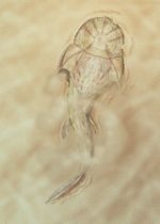
Phyllolepis
Encyclopedia
Phyllolepis is the type genus
of Phyllolepida
, an extinct order
of placoderm fish
from the Devonian
.
Phyllolepis lived in freshwater environments, possibly rivers and streams. As with all other known phyllolepids, the species of Phyllolepis were presumed to have been blind, bottom-dwelling predators that detected prey through sensory organs in the surface grooves of their armor plates (which give their plates a distinctive "wooden surface" appearance). Their fossils are found in Europe
and North America
.
Type genus
In biological classification, a type genus is a representative genus, as with regard to a biological family. The term and concept is used much more often and much more formally in zoology than it is in botany, and the definition is dependent on the nomenclatural Code that applies:* In zoological...
of Phyllolepida
Phyllolepida
The order Phyllolepida was an order of flattened placoderms found throughout the world, with fossils being found in Devonian strata. Like other flattened placoderms, the phyllolepids were bottom-dwelling predators that ambushed prey...
, an extinct order
Order (biology)
In scientific classification used in biology, the order is# a taxonomic rank used in the classification of organisms. Other well-known ranks are life, domain, kingdom, phylum, class, family, genus, and species, with order fitting in between class and family...
of placoderm fish
Fish
Fish are a paraphyletic group of organisms that consist of all gill-bearing aquatic vertebrate animals that lack limbs with digits. Included in this definition are the living hagfish, lampreys, and cartilaginous and bony fish, as well as various extinct related groups...
from the Devonian
Devonian
The Devonian is a geologic period and system of the Paleozoic Era spanning from the end of the Silurian Period, about 416.0 ± 2.8 Mya , to the beginning of the Carboniferous Period, about 359.2 ± 2.5 Mya...
.
Phyllolepis lived in freshwater environments, possibly rivers and streams. As with all other known phyllolepids, the species of Phyllolepis were presumed to have been blind, bottom-dwelling predators that detected prey through sensory organs in the surface grooves of their armor plates (which give their plates a distinctive "wooden surface" appearance). Their fossils are found in Europe
Europe
Europe is, by convention, one of the world's seven continents. Comprising the westernmost peninsula of Eurasia, Europe is generally 'divided' from Asia to its east by the watershed divides of the Ural and Caucasus Mountains, the Ural River, the Caspian and Black Seas, and the waterways connecting...
and North America
North America
North America is a continent wholly within the Northern Hemisphere and almost wholly within the Western Hemisphere. It is also considered a northern subcontinent of the Americas...
.
Sources
- Wildlife of Gondwana: Dinosaurs and Other Vertebrates from the Ancient Supercontinent (Life of the Past) by Pat Vickers Rich, Thomas Hewitt Rich, Francesco Coffa, and Steven Morton
- The Rise of Fishes: 500 Million Years of Evolution by John A. Long
External links
- Phyllolepida at Palaeos.com

